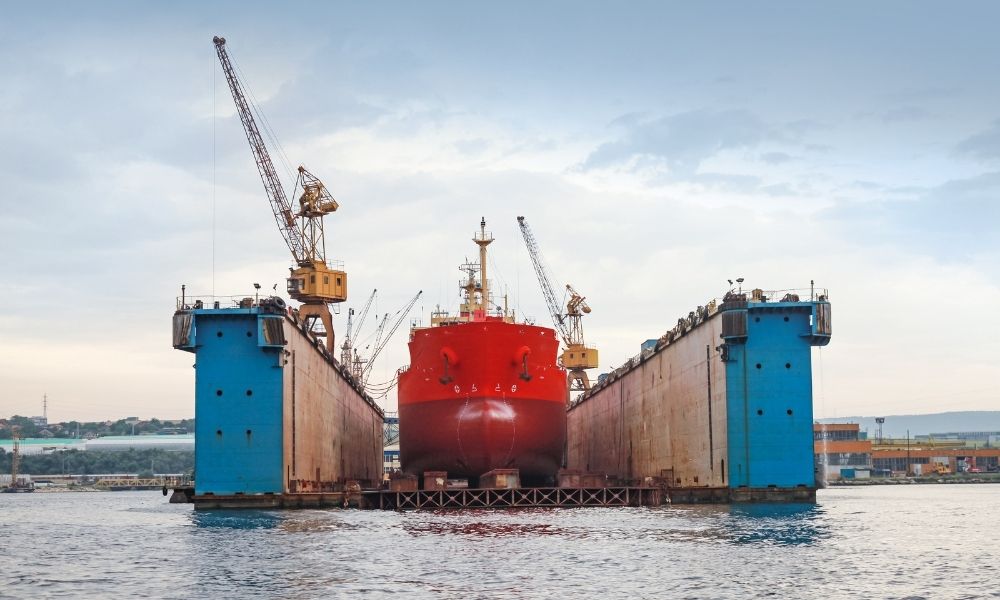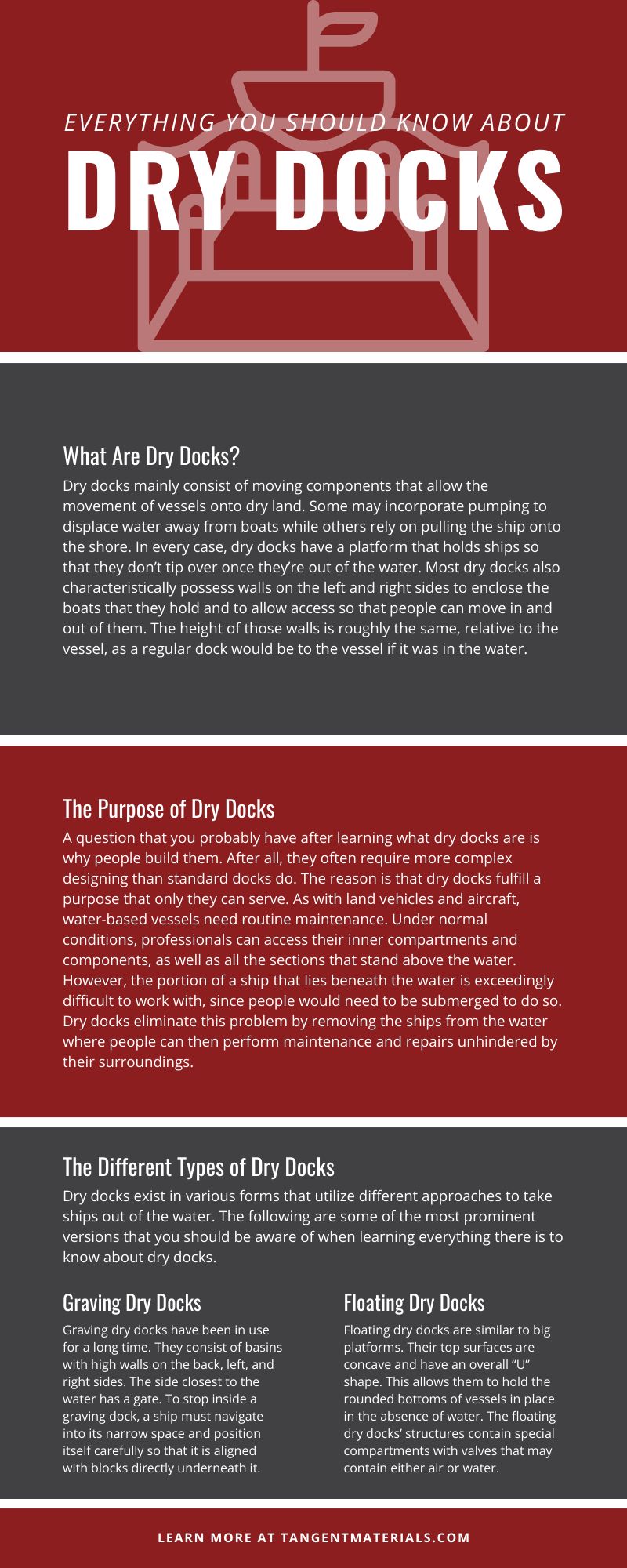Everything You Should Know About Dry Docks

You’re more than likely already acquainted with regular docks. They come in many shapes and sizes to allow people to securely stop boats that are large or small right next to land. Without them, it would be difficult to enter and exit a ship, as well as move cargo onto and off of one. Docks also keep vessels from moving in the water so that they don’t get swept away or become damaged as they crash into other objects. A more specialized form of docks is dry docks. The term dry dock can actually refer both to an action and a specific structure. Dry docking is the process of moving a ship out of the water and onto land. The physical assemblies that we’re discussing here are also called dry docks. They allow people to bring ships onto land, unlike regular docks where the vessels remain floating in the water. We present everything you should know about dry docks so that you can be more prepared should you need to construct them.
What Are Dry Docks?
Dry docks mainly consist of moving components that allow the movement of vessels onto dry land. Some may incorporate pumping to displace water away from boats while others rely on pulling the ship onto the shore. In every case, dry docks have a platform that holds ships so that they don’t tip over once they’re out of the water. Most dry docks also characteristically possess walls on the left and right sides to enclose the boats that they hold and to allow access so that people can move in and out of them. The height of those walls is roughly the same, relative to the vessel, as a regular dock would be to the vessel if it was in the water.
The Purpose of Dry Docks
A question that you probably have after learning what dry docks are is why people build them. After all, they often require more complex designing than standard docks do. The reason is that dry docks fulfill a purpose that only they can serve. As with land vehicles and aircraft, water-based vessels need routine maintenance. Under normal conditions, professionals can access their inner compartments and components, as well as all the sections that stand above the water. However, the portion of a ship that lies beneath the water is exceedingly difficult to work with, since people would need to be submerged to do so. These docks eliminate this problem by removing the ships from the water where people can then perform maintenance and repairs unhindered by their surroundings.
It’s also important to note that dry docks can be useful in the initial shipbuilding process. Again, it would be quite hard and impractical to attempt to construct a vessel directly in the water. Dry docks offer one method for people to create ships and then safely launch them into the water once they’re complete.
The Different Types of Dry Docks
Dry docks exist in various forms that utilize different approaches to take ships out of the water. The following are some of the most prominent versions that you should be aware of when learning everything there is to know about dry docks.
Graving Dry Docks
Graving dry docks have been in use for a long time. They consist of basins with high walls on the back, left, and right sides. The side closest to the water has a gate. To stop inside a graving dock, a ship must navigate into its narrow space and position itself carefully so that it is aligned with blocks directly underneath it. From there, the gate closes and operators pump water out of the graving dry dock’s basin. The ship’s full weight then comes to rest on the blocks and the space is ready for people to enter and bring equipment to check the boat’s hull and make necessary repairs.
The walls of graving docks are usually made of concrete and steel. The support blocks can likewise be constructed out of concrete and steel, though stone, timber, and plastic timber are also valid options as well. Gates are commonly steel and can appear in hinged variants, with two pieces that open at the center of roller variants that consist of one piece and slide in and out of position. Graving dry docks are best for large ships and afford the most freedom for making modifications to them without the interference of water. This is because they’re located directly on the land and can have ramps that make moving materials and tools to and from them simple.
Floating Dry Docks
Floating dry docks are similar to big platforms. Their top surfaces are concave and have an overall “U” shape. This allows them to hold the rounded bottoms of vessels in place in the absence of water. The floating structures contain special compartments with valves that may contain either air or water. When a ship arrives, operators open the valves to let water into the chambers so that the floating dry dock sinks underwater. The boat then moves over the dock, at which point the dock pumps water out of the compartments again. The dock then floats above the water, bringing the ship up with it. Due to how they function, floating docks are not always directly connected to the land and may stand apart in open water near the shore. They frequently feature left and right-side walls in order to keep their platforms straight as they move up and down in the water.
Floating dry docks are mainly composed of steel. They are moveable, so they can accommodate damaged ships easier than graving dry docks. In areas where the ground is too unstable to build large graving dry docks, floating docks may be the best alternative. However, the fact that floating dry docks sit in the water means that their own maintenance can be tricky.
Slipways
Slipways are designed for smaller-sized vessels. They have inclined ramps with moving trolleys that boats can sit on. Once a boat is properly aligned with the trolley in the water, the slipway can pull it up onto the land mechanically. In addition, slipways can be convenient for building new ships and launching them into the water. The slipway itself is usually made of normal paving materials like concrete, while the trolley and its tracks can be made of metal, wood, or plastic wood.
Shiplifts
Shiplifts are advanced dry docks that have platforms that move straight up and down to raise vessels out of the water. They differ from floating docks in that they are usually directly connected to the land and use electrical and mechanical means in the form of winches to generate movement instead of flotation. Shiplifts are valuable for bringing heavy vessels that weigh around 800 to 25,000 tons out of the water, as well as submarines. Materials that you might use to create shiplifts include concrete, steel wood, steel, plastic wood, and rubber for extra cushioning on supporting blocks.
Obtain all your marine-grade lumber made of durable HDPE plastic by contacting Tangent today. Our products do not corrode or rot even when constantly exposed to water. They’re also strong enough to help guide and support vessels in dry docks.













